
SHT Blue Blaze Blitz Post
Our weekend on the Superior Hiking Trail.
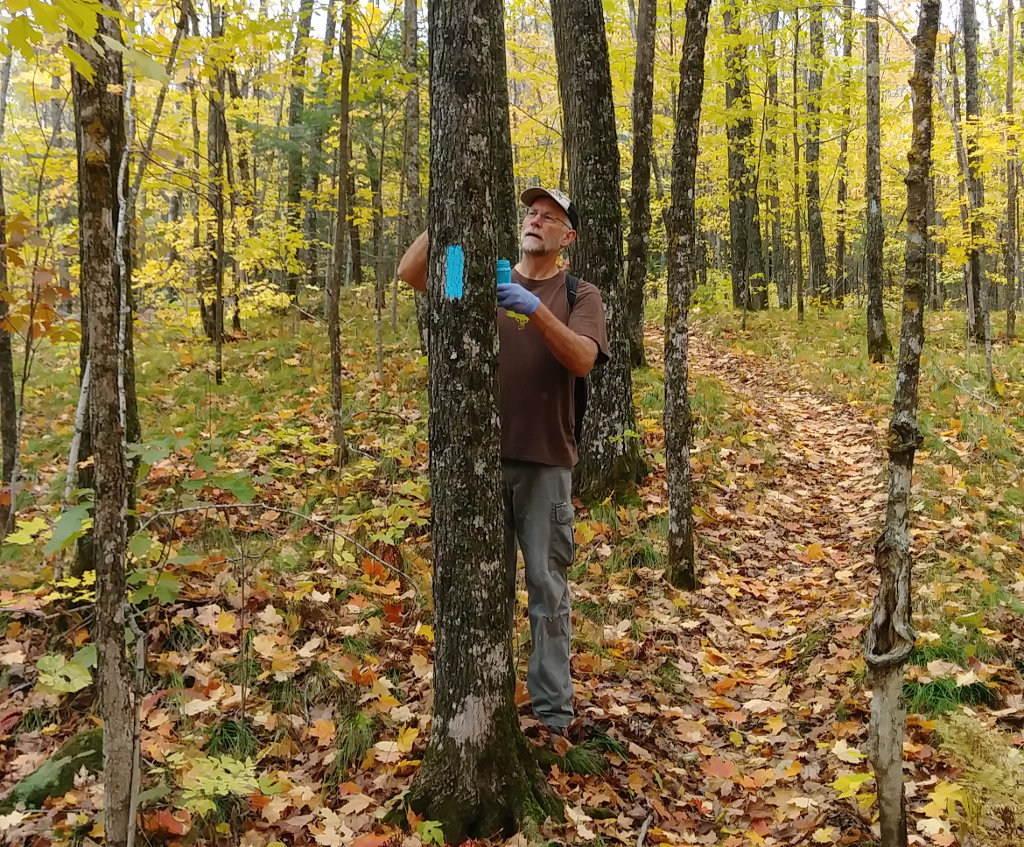
 We had a wonderful weekend doing trail volunteer work on the Superior Hiking Trail this weekend. We painted blazes on about 17 miles of trail as our part of the #BlueBlazeBlitz that saw pairs of volunteers blazing the majority of the 300+ trail miles along the north shore of Lake Superior.
We had a wonderful weekend doing trail volunteer work on the Superior Hiking Trail this weekend. We painted blazes on about 17 miles of trail as our part of the #BlueBlazeBlitz that saw pairs of volunteers blazing the majority of the 300+ trail miles along the north shore of Lake Superior.
The trail was completely blazed in 2006-2007 by two people contracted by the SHT Association. At that time, the standard of a vertical blue blaze measuring 2-inch by 6-inch and positioned about 6 feet from the ground every 1/10th mile was set. Over the past dozen years, those blazes have faded, or the trees they were on have fallen. On my thru-hike, I joked that the SHTA should use a paint that wouldn't kill the trees since I saw so many on the ground. :-)
Our blazes in 2019 are still blue, and about the size of a dollar bill, but we were instructed to place them about every 100 yards, so they are about half the distance apart as the originals.
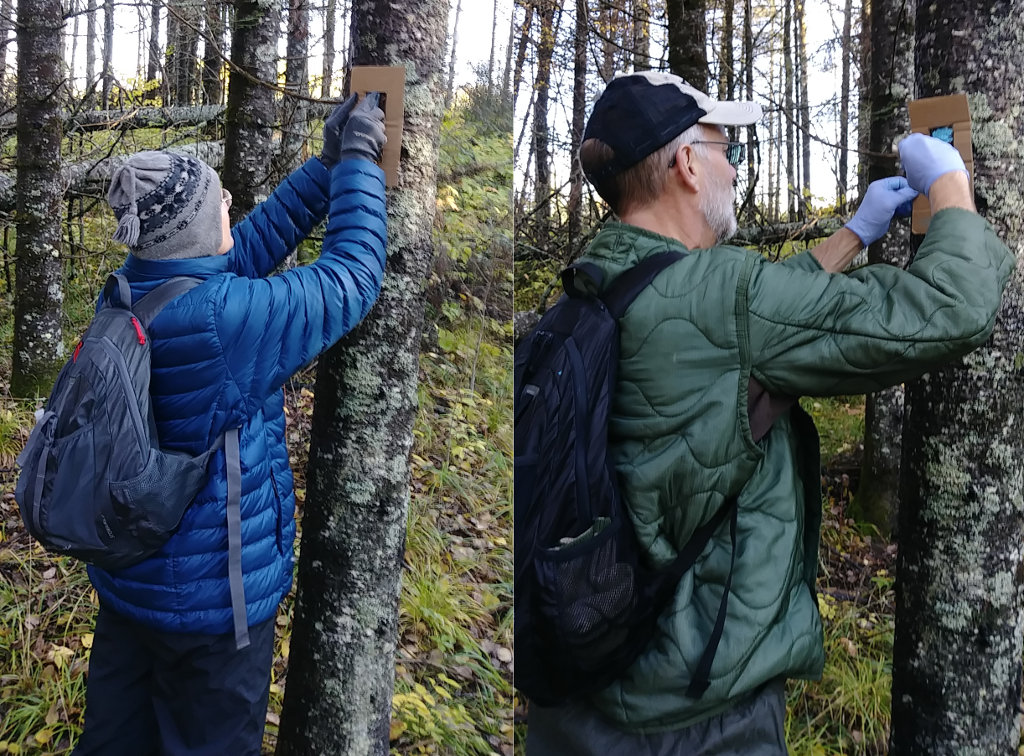
 The process is pretty simple.
The process is pretty simple.
Count 100 steps and find a tree for a blaze. Clean an area 6 feet up. Paint the blaze. Repeat 20 times every mile. But, there are some things to learn to make 'good' blazes.
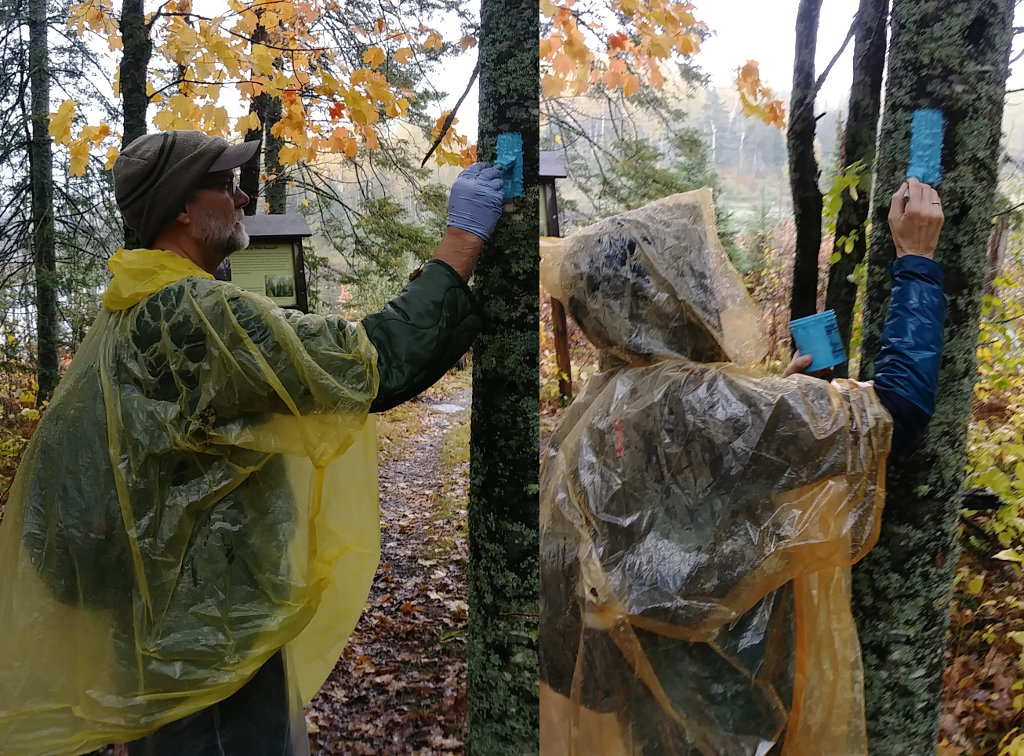
 For our volunteering, we blazed on both Saturday and Sunday. Our longest assigned section was on Saturday and it rained the entire day, non-stop. But, we were told the blazing would go on 'rain or shine', so we successfully covered the 5 miles out and 5 miles back in about 7 hours. After we finished, we learned that some groups chose to not blaze due to the rain, so now we hope our blazes hold up. We did meet another blazer leaving the trail and she had done her section - Good Job!
For our volunteering, we blazed on both Saturday and Sunday. Our longest assigned section was on Saturday and it rained the entire day, non-stop. But, we were told the blazing would go on 'rain or shine', so we successfully covered the 5 miles out and 5 miles back in about 7 hours. After we finished, we learned that some groups chose to not blaze due to the rain, so now we hope our blazes hold up. We did meet another blazer leaving the trail and she had done her section - Good Job!
You can see we are wet under our disposable rain ponchos. Most of that was from perspiration being trapped and we were plenty warm the entire time. The only time I cooled off was when we stopped for a quick lunch in a very convenient snowmobile shelter along the trail. As long as we were walking along, it was comfortable - wet, windy, and cool, but still comfortable.
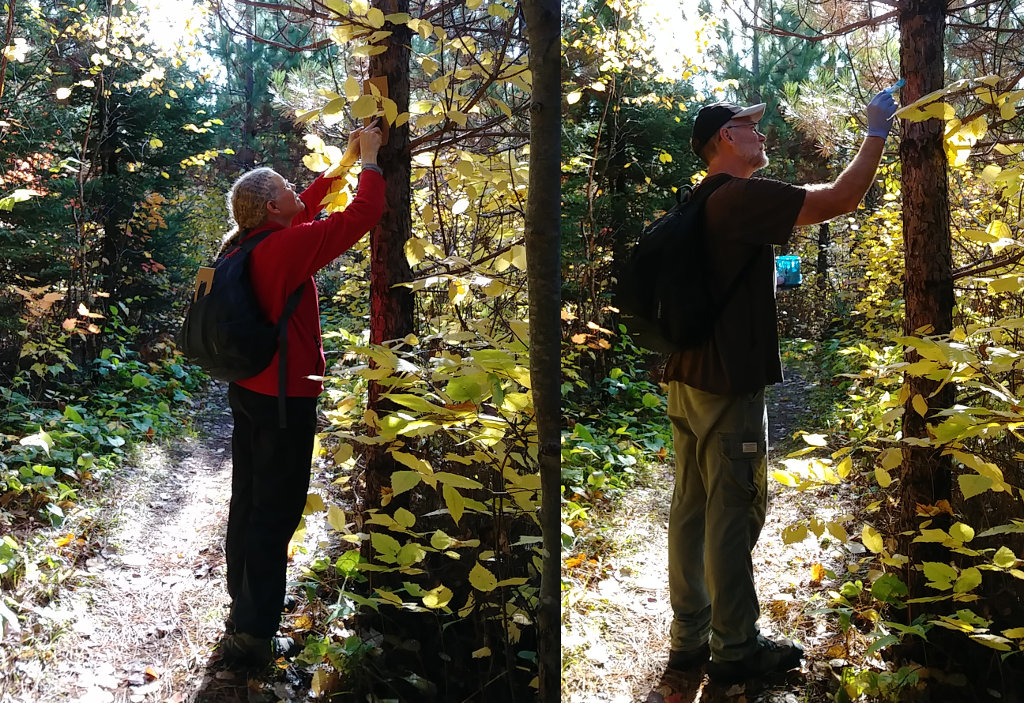
 Sunday's hike was so much more fun! The sun was out and it was a perfect fall day. Our second section was 7 miles round-trip and the blazes were much easier to paint without rainwater to deal with.
Sunday's hike was so much more fun! The sun was out and it was a perfect fall day. Our second section was 7 miles round-trip and the blazes were much easier to paint without rainwater to deal with.
We tromped through a lot of water left over from the storm, but stayed dry overall. A nice lunch at the Big Bend campsite at our halfway point was our only rest in the 5 hour hike.

 It was nice to be out in the woods at this time of year. Lots of colors changing, cool temps, and no bugs. These were just a few of the beautiful trees we passed. My favorite part was walking through a maple forest with a canopy of orange and red lit by sunshine.
It was nice to be out in the woods at this time of year. Lots of colors changing, cool temps, and no bugs. These were just a few of the beautiful trees we passed. My favorite part was walking through a maple forest with a canopy of orange and red lit by sunshine.
If you take advantage of hiking on trails, please consider contributing to their maintenance. The SHT is volunteer maintained, as are many trails across the country. It takes many hours of commitment by many people to keep trails open and available for you.
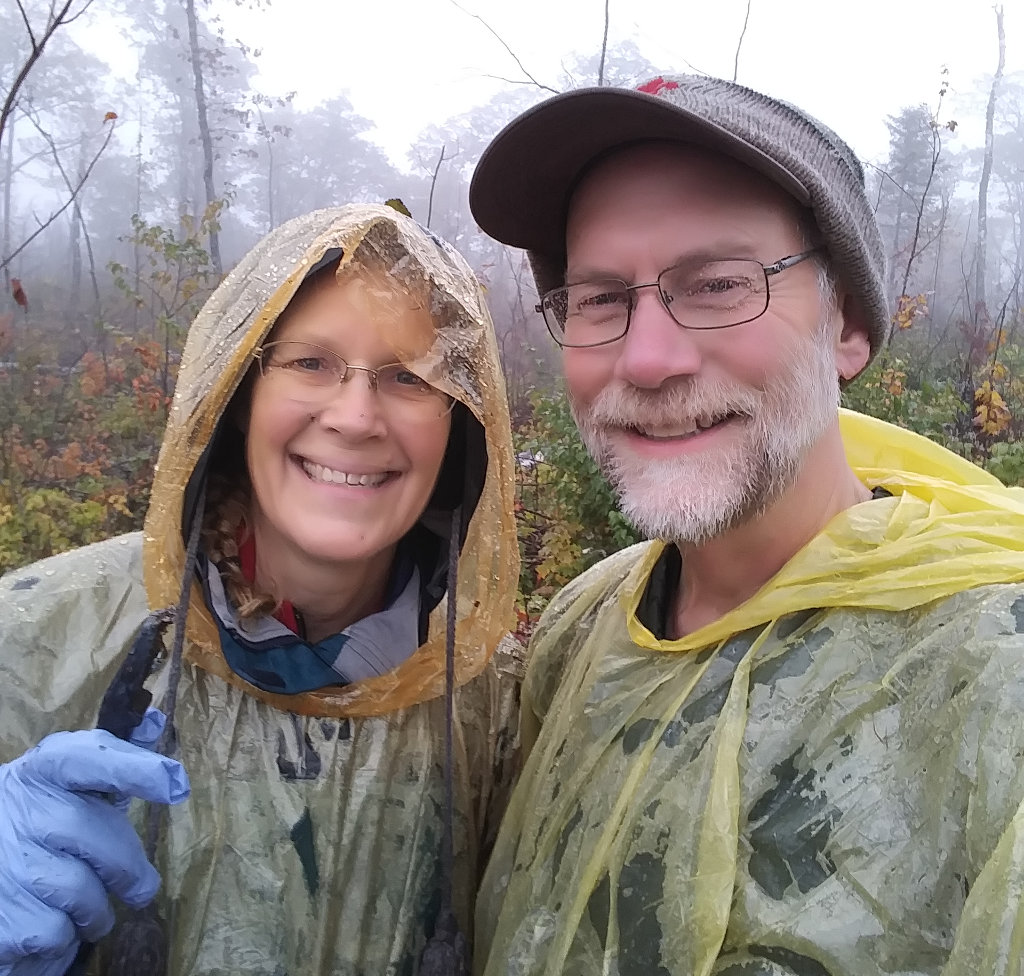
 Hike On
Hike On

 We had a wonderful weekend doing trail volunteer work on the Superior Hiking Trail this weekend. We painted blazes on about 17 miles of trail as our part of the #BlueBlazeBlitz that saw pairs of volunteers blazing the majority of the 300+ trail miles along the north shore of Lake Superior.
We had a wonderful weekend doing trail volunteer work on the Superior Hiking Trail this weekend. We painted blazes on about 17 miles of trail as our part of the #BlueBlazeBlitz that saw pairs of volunteers blazing the majority of the 300+ trail miles along the north shore of Lake Superior.The trail was completely blazed in 2006-2007 by two people contracted by the SHT Association. At that time, the standard of a vertical blue blaze measuring 2-inch by 6-inch and positioned about 6 feet from the ground every 1/10th mile was set. Over the past dozen years, those blazes have faded, or the trees they were on have fallen. On my thru-hike, I joked that the SHTA should use a paint that wouldn't kill the trees since I saw so many on the ground. :-)
Our blazes in 2019 are still blue, and about the size of a dollar bill, but we were instructed to place them about every 100 yards, so they are about half the distance apart as the originals.

 The process is pretty simple.
The process is pretty simple.Count 100 steps and find a tree for a blaze. Clean an area 6 feet up. Paint the blaze. Repeat 20 times every mile. But, there are some things to learn to make 'good' blazes.
- A Good Tree is large enough to fit a blaze on, not a spindly sapling. Birch and White Pine should be avoided because their bark peels or flakes and won't hold the blaze long. A tree that is visible from far down the trail works well, rather than one just around a corner, or covered by brush.
- Scraping off lichen, moss, and debris to create a smooth canvas makes for a better blaze. We were given a template and scraper to define the blaze location.
- Using a small amount of paint and brushing up from the bottom reduces newbie drips.
- If there's an old blaze in the general area that would work, just repainting it is the thing to do.

 For our volunteering, we blazed on both Saturday and Sunday. Our longest assigned section was on Saturday and it rained the entire day, non-stop. But, we were told the blazing would go on 'rain or shine', so we successfully covered the 5 miles out and 5 miles back in about 7 hours. After we finished, we learned that some groups chose to not blaze due to the rain, so now we hope our blazes hold up. We did meet another blazer leaving the trail and she had done her section - Good Job!
For our volunteering, we blazed on both Saturday and Sunday. Our longest assigned section was on Saturday and it rained the entire day, non-stop. But, we were told the blazing would go on 'rain or shine', so we successfully covered the 5 miles out and 5 miles back in about 7 hours. After we finished, we learned that some groups chose to not blaze due to the rain, so now we hope our blazes hold up. We did meet another blazer leaving the trail and she had done her section - Good Job!You can see we are wet under our disposable rain ponchos. Most of that was from perspiration being trapped and we were plenty warm the entire time. The only time I cooled off was when we stopped for a quick lunch in a very convenient snowmobile shelter along the trail. As long as we were walking along, it was comfortable - wet, windy, and cool, but still comfortable.

 Sunday's hike was so much more fun! The sun was out and it was a perfect fall day. Our second section was 7 miles round-trip and the blazes were much easier to paint without rainwater to deal with.
Sunday's hike was so much more fun! The sun was out and it was a perfect fall day. Our second section was 7 miles round-trip and the blazes were much easier to paint without rainwater to deal with.We tromped through a lot of water left over from the storm, but stayed dry overall. A nice lunch at the Big Bend campsite at our halfway point was our only rest in the 5 hour hike.

 It was nice to be out in the woods at this time of year. Lots of colors changing, cool temps, and no bugs. These were just a few of the beautiful trees we passed. My favorite part was walking through a maple forest with a canopy of orange and red lit by sunshine.
It was nice to be out in the woods at this time of year. Lots of colors changing, cool temps, and no bugs. These were just a few of the beautiful trees we passed. My favorite part was walking through a maple forest with a canopy of orange and red lit by sunshine.If you take advantage of hiking on trails, please consider contributing to their maintenance. The SHT is volunteer maintained, as are many trails across the country. It takes many hours of commitment by many people to keep trails open and available for you.

 Hike On
Hike OnPosted: 15:32 10-07-2019 1490
Prev: 2019 BWCA Canoe Trek
Next: Compass TrainingSite Disclosure Statement
Next: Compass Training
archives: 2025 2024 2023 2022 2021 2020 2019 2018 2017 2016 2015 2014 2013 2012 2011
Find more Hiking Resources at www.HikingDude.com


Follow Me
Recent Comments